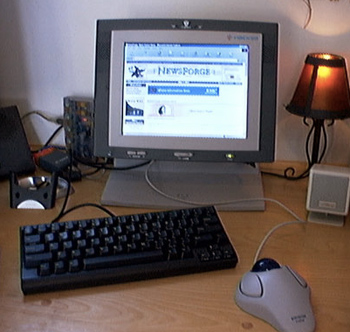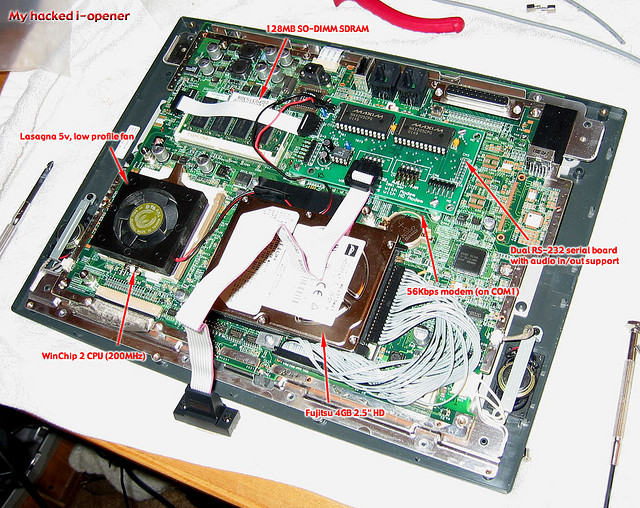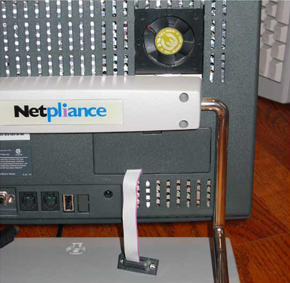 I scan eBay’s vintage computer area daily — a few times a day, actually — to keep an eye on what’s passing through. The other day I saw a new-in-box Netpliance i-Opener pop up, and that took me back a few years.
I scan eBay’s vintage computer area daily — a few times a day, actually — to keep an eye on what’s passing through. The other day I saw a new-in-box Netpliance i-Opener pop up, and that took me back a few years.
Between 1999 and 2002, a company called Netpliance sold an “internet appliance” known as the i-Opener for $99, for the purpose of providing Internet access to customers via their monthly (paid) dial-up service. The i-Opener was a loss-leader, costing the company something between $300 and $400 to produce. The real money was to be made via the Internet service but, early on, there was no binding service contract, so users were free to purchase the device and forget about paying the monthly fee.
But, why would they do that?
It turns out the i-Opener was, in fact, a pretty standard low-end PC. It featured a 9-inch color LCD, a 180MHZ WinChip C6 processor, an SO-DIMM socket, an IDE interface, a single USB port, and partial serial ports. It presented the user with a super-simple interface to the Internet running on QNX in 16MB of flash RAM. Once it was discovered that under that dumbed-down graphical interface sat a real PC, a number of i-Opener modding websites popped up and folks got busy turning this little $99 beauty into a functional PC. And, I was among them.
 In the summer of 2000 I grabbed an i-Opener for $99 and, based on information gleaned from the aforementioned websites, set out to turn the i-Opener into a useful computer. And, I had real motivation in the effort; I was in the process of selling my Power Mac G3 system a couple of months before the new G4 systems arrived (to maximize resale value), and the i-Opener was going to be my main machine for a while.
In the summer of 2000 I grabbed an i-Opener for $99 and, based on information gleaned from the aforementioned websites, set out to turn the i-Opener into a useful computer. And, I had real motivation in the effort; I was in the process of selling my Power Mac G3 system a couple of months before the new G4 systems arrived (to maximize resale value), and the i-Opener was going to be my main machine for a while.
 After a few weeks I had all the parts I needed to begin surgery on the unit. The first thing I did was remove the 180MHz WinChip C6 and replace it with a 200MHz WinChip 2 that featured a number of enhancements beyond the mere 20MHz clock jump. The CPU needed extra cooling, so I cut through the RF shield and the plastic backplate of the unit and mounted a low-voltage cooling fan. I also added a 2.5-inch, 4GB IDE hard drive and a custom interface board that provided a real, functioning serial port (for use interfacing with my Compaq iPaq PDA, of course). Next, came the powered USB hub and the LinkSys USB-to-ethernet adapter. Finally, a PS/2-style breakout cable let me replace the unit’s weak keyboard and its integrated track knob with a proper keyboard, the Happy Hacking Keyboard 2 Lite (that’s currently doing service on my Raspberry Pi), and a Kensington trackball.
After a few weeks I had all the parts I needed to begin surgery on the unit. The first thing I did was remove the 180MHz WinChip C6 and replace it with a 200MHz WinChip 2 that featured a number of enhancements beyond the mere 20MHz clock jump. The CPU needed extra cooling, so I cut through the RF shield and the plastic backplate of the unit and mounted a low-voltage cooling fan. I also added a 2.5-inch, 4GB IDE hard drive and a custom interface board that provided a real, functioning serial port (for use interfacing with my Compaq iPaq PDA, of course). Next, came the powered USB hub and the LinkSys USB-to-ethernet adapter. Finally, a PS/2-style breakout cable let me replace the unit’s weak keyboard and its integrated track knob with a proper keyboard, the Happy Hacking Keyboard 2 Lite (that’s currently doing service on my Raspberry Pi), and a Kensington trackball.
I installed Windows 98 on the system and, in the end, had a rather functional machine to keep me in business while I was between my 300MHz PowerMac G3 and my dual-G4 800MHz PowerMac to come. I had fun replaying DOOM II on the unit and wrote with it some of my more memorable MacRumors posts during my two-year tenure at the start of the site.
I sold the unit not long after my new G4 arrived, but I kind of wish I had kept it. I see there are a few of them on eBay right now, as I write this post, but I don’t think I’ll dip back in to relive the i-Opener adventure. It made for a nice story though, I think.
An amusing side-note to this story is the phone call I received from a Netpliance rep, a few weeks after purchasing the unit, instructing me to begin paying for their monthly service. I pointed out that when I bought the unit, no binding service contract was part of the bundle and that I had already heavily modified the device. (The company had, since, corrected matters in their TOS agreement and even began cutting the pins off the IDE connector, of which I was aware). The rep then pointed out to me that they had decided to retroactively apply a binding contract to all units sold. After offering up a stunned pause followed by a bit of laughter, I said goodbye to the woman on the other end of the line and, of course, never heard anything else about the matter.

I wonder how many people fell for the retroactive “contract”.
Can you recall the steps to get a USB to Ethernet dongle working under 98SE? I’ve tried on my Compaq IA-1 and haven’t succeeded. 98 only seems to recognize USB keyboards and mice.
Wow. It’s been…some time since then. I am afraid I do not. I think the drivers for the device I used were avail online and I just downloaded them and they worked. It might well have been the “USB100TX Linksys EtherFast 10/100 USB Network Adapter,” which is now a fairly vintage thing…
Just like Blake, I was also running the Linksys EtherFast USB100TX. I just pulled mu i-opener out of storage yesterday and was playing with it.
As a side note, I used that Linksys USB100TX all the time when setting up computers. It just worked. Rock solid adapter.
My 95 year old mother in law has one of these and for years sent and received emails from family members. She has not been able to use it in years. I’m trying o find one one who can get those emails or at least print them. Any ideas?
Hmmm. I assume she used it as it was intended, with the iOpener company internet service. I assume that has long been defunct. I have no idea if it’s possible to access that data, as such, or if some of the emails were stored on the device itself. I never used the iOpener “as intended,” I’m afraid. It was a Windows scenario, for me.
Good luck…
If they were stored on Netpliance’s server, then they are gone forever as that service has not been in operation for many years. Your only hope is if they were stored locally on the device somehow, but seeing as they only came with a small amount of flash memory standard and no hard drive, they probably wouldn’t be stored there, either.
I had an I-Opener too, and actually used it as intended. It was taken over by Earthlink (which is still in business, but I do not know if they still support it) I was just thinking about the screen, and I think the “News” “Finance” “Entertainment” icons could have influenced Steve Jobs’ creation of the Iphone (similar name, huh?) and Apps!
Amazon still has one in stock. Unfortunately, you still have to sign up for their internet servive apparently ;) http://www.amazon.com/NetPliance-ASY200-01-Netplaince-i-opener-Appliance/dp/B000051SI7
I have 2 available, one hacked running win 98 on 40gb drive, and one new and unhacked, both in the boxes. Anyone interested get in touch quick (bill at billsville dot com), I’m moving in Sept this year (2014) and they aren’t moving with me. Unless you live around Seattle, my destination, then they could ride with our stuff.
Also have a Macintosh Color Classic and Macintosh SE/30, Amiga 500 (in the box), TRS Color Computer II (Radio Shack CoCo2), and other gems.
Oh yes, a Kaypro II (there was no I), and an Osborne I, considered to be the first portable computer.
Now it’s September 2018, a new company is bringing back a concept very similar to Netpliance. “MyGait, a computer designed for seniors, by Dell. Just plug it in and you’re ready to go!” Only this one has one more 9 in the price, $999.00. https://www.mygait.com/senior-computer.html
It was because of things like this, that cell phones come with service contracts, today. You can’t walk into a T-Mobile store, and tell them you want your “free” iPhone, but you don’t want a service contract. People really think the mobile providers are so stupid, that they will give phones away for free, so the people who get them can sell them on ebay, without agreeing to a service contract. I saw a woman try pulling this in a Radio Shack, once. She even waved the “free phone” offer, in the circular, at the poor guy working behind the counter, who tried explaining, in vain, that the “free phone”, is only available with a service contract, otherwise she would have to pay full price for it, but she wasn’t hearing it. As far as she was concerned, the circular said “free phone”, and she didn’t care about the fine print that said a service contract was required.
Pingback: 13 Of The Weirdest Gadgets Sold In The 1990s – 1today